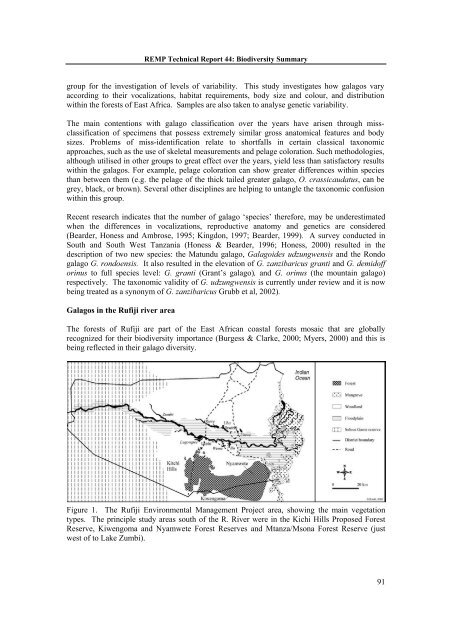Family / Scientific name - Coastal Forests of Kenya and Tanzania
Family / Scientific name - Coastal Forests of Kenya and Tanzania
Family / Scientific name - Coastal Forests of Kenya and Tanzania
You also want an ePaper? Increase the reach of your titles
YUMPU automatically turns print PDFs into web optimized ePapers that Google loves.
REMP Technical Report 44: Biodiversity Summary<br />
group for the investigation <strong>of</strong> levels <strong>of</strong> variability. This study investigates how galagos vary<br />
according to their vocalizations, habitat requirements, body size <strong>and</strong> colour, <strong>and</strong> distribution<br />
within the forests <strong>of</strong> East Africa. Samples are also taken to analyse genetic variability.<br />
The main contentions with galago classification over the years have arisen through missclassification<br />
<strong>of</strong> specimens that possess extremely similar gross anatomical features <strong>and</strong> body<br />
sizes. Problems <strong>of</strong> miss-identification relate to shortfalls in certain classical taxonomic<br />
approaches, such as the use <strong>of</strong> skeletal measurements <strong>and</strong> pelage coloration. Such methodologies,<br />
although utilised in other groups to great effect over the years, yield less than satisfactory results<br />
within the galagos. For example, pelage coloration can show greater differences within species<br />
than between them (e.g. the pelage <strong>of</strong> the thick tailed greater galago, O. crassicaudatus, can be<br />
grey, black, or brown). Several other disciplines are helping to untangle the taxonomic confusion<br />
within this group.<br />
Recent research indicates that the number <strong>of</strong> galago ‘species’ therefore, may be underestimated<br />
when the differences in vocalizations, reproductive anatomy <strong>and</strong> genetics are considered<br />
(Bearder, Honess <strong>and</strong> Ambrose, 1995; Kingdon, 1997; Bearder, 1999). A survey conducted in<br />
South <strong>and</strong> South West <strong>Tanzania</strong> (Honess & Bearder, 1996; Honess, 2000) resulted in the<br />
description <strong>of</strong> two new species: the Matundu galago, Galagoides udzungwensis <strong>and</strong> the Rondo<br />
galago G. rondoensis. It also resulted in the elevation <strong>of</strong> G. zanzibaricus granti <strong>and</strong> G. demid<strong>of</strong>f<br />
orinus to full species level: G. granti (Grant’s galago), <strong>and</strong> G. orinus (the mountain galago)<br />
respectively. The taxonomic validity <strong>of</strong> G. udzungwensis is currently under review <strong>and</strong> it is now<br />
being treated as a synonym <strong>of</strong> G. zanzibaricus Grubb et al, 2002).<br />
Galagos in the Rufiji river area<br />
The forests <strong>of</strong> Rufiji are part <strong>of</strong> the East African coastal forests mosaic that are globally<br />
recognized for their biodiversity importance (Burgess & Clarke, 2000; Myers, 2000) <strong>and</strong> this is<br />
being reflected in their galago diversity.<br />
Figure 1. The Rufiji Environmental Management Project area, showing the main vegetation<br />
types. The principle study areas south <strong>of</strong> the R. River were in the Kichi Hills Proposed Forest<br />
Reserve, Kiwengoma <strong>and</strong> Nyamwete Forest Reserves <strong>and</strong> Mtanza/Msona Forest Reserve (just<br />
west <strong>of</strong> to Lake Zumbi).<br />
91

















